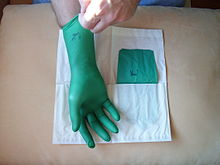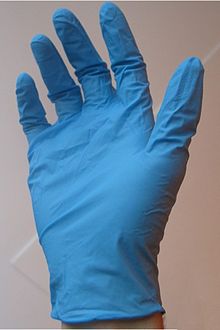- Medical glove
-
Medical gloves are disposable gloves used during medical examinations and procedures that help prevent contamination between caregivers and patients.[1] Medical gloves are made of different polymers including latex, nitrile rubber, vinyl and neoprene; they come unpowdered, or powdered with cornstarch to lubricate the gloves, making them easier to put on the hands.[2] Cornstarch replaced tissue-irritating Lycopodium powder and talc, but since even cornstarch can impede healing if it gets into tissues (as during surgery), unpowdered gloves are being used more often during surgery and other sensitive procedures. Special manufacturing processes are used to compensate for the lack of powder. There are two main types of gloves: exam and surgical. Surgical gloves have more precise sizing with a better precision and sensitivity and are made to a higher standard.
Contents
History
In 1890 William Stewart Halsted was the first to use sterilized medical gloves when he was at Johns Hopkins University.[3][4] With the publication of germ theory Halsted was using carbolic acid, introduced by Joseph Lister, to sterilize his hands and his nurse's hands. She was sensitive to the chemical, and it was damaging the skin on her hands; so he asked the Goodyear Tire and Rubber Company if they could make a glove of rubber that could be dipped in carbolic acid.
The first disposable latex medical gloves were manufactured in 1964 by Ansell. They based the production on the technique for making condoms.[5]
Latex allergy and alternative materials
Due to the increasing rate of latex allergy among health professionals, and in the general population, gloves made of non-latex materials such as vinyl, nitrile rubber or neoprene have become widely used. Chemical processes may be employed to reduce the amount of antigenic protein in Hevea latex, resulting in alternative natural-rubber-based materials such Vytex Natural Rubber Latex. However, non-latex gloves have not yet replaced latex gloves in surgical procedures, as gloves made of alternative materials generally do not fully match the fine control or greater sensitivity to touch available with latex surgical gloves. (High-grade Isoprene gloves are the only exception to this rule, as they have the same chemical structure as natural latex rubber. However, fully artificial polyisoprene—rather than 'hypoallergenic' cleaned natural latex rubber[6]--is also the most expensive natural latex substitute available.[7]) Other high-grade non-latex gloves, such as nitrile gloves, can cost over twice the price of their latex counterparts, a fact that has often prevented switching to these alternative materials in cost-sensitive environments, such as many hospitals.[8]
Powder-free medical gloves are used in medical cleanroom environments, where the need for cleanliness is often similar to that in a sensitive medical environment.[citation needed] Similar but specially tested gloves are used in electronics cleanrooms.[citation needed]
References
- ^ "Medical Gloves and Gowns". FDA. http://www.fda.gov/cdrh/ppe/gloves.html. Retrieved 2010-03-10. "Medical gloves are disposable gloves used during medical procedures. Medical gloves help prevent contamination between caregivers and patients. Some are designed to prevent contact with certain chemotherapy drugs. Medical gloves include examination gloves, surgical gloves, and medical gloves for handling chemotherapy agents (chemotherapy gloves). These gloves are regulated by the Food and Drug Administration (FDA). FDA makes sure that manufacturers of these devices meet performance criteria such as leak resistance, tear resistance, etc."
- ^ Glove manufacturing
- ^ "Hopkins Ceases Use Of Latex Gloves During Surgery". WJZ-TV. January 15, 2008. http://wjz.com/local/johns.hopkins.hospital.2.629922.html. Retrieved 2010-03-03. "A surgeon at Johns Hopkins Hospital is credited with being the first to introduce the rubber surgical glove back in 1894."
- ^ "Rubber Gloves". Johns Hopkins Hospital. January 14, 2008. http://www.hopkinsmedicine.org/press_releases/2008/01_15_08.html. Retrieved 2010-03-03. "William Stewart Halsted, The Johns Hopkins Hospital’s first surgeon in chief, is credited as the first to develop and introduce rubber surgical gloves in the United States. That was in 1894, five years after the institution opened."
- ^ "100 Years of Australian Innovation - latex gloves". http://www.biotechnology-innovation.com.au/innovations/instruments/latex_gloves.html. Retrieved 2010-03-07. "In 1945, Ansell designed and built the first automatic dipping machine, which produced 300 dozen pairs of synthetic gloves in eight hours. Ansell introduced disposable surgical gloves in 1964, which won the company an Export Award in 1967. International expansion over the next two decades saw Ansell become the world's largest producer of latex gloves for household and medical use."
- ^ http://www.fda.gov/MedicalDevices/DeviceRegulationandGuidance/GuidanceDocuments/ucm070925.htm
- ^ http://www.surgicalglove.net/polyisoprene.html
- ^ Advantages and Disadvantages of Non-latex Surgical Gloves
External links
- Choosing the Correct Glove
- Choosing the Right Examination Glove
- An article discussing nitrile vs. latex for gloves
- Quality Standards for Nitrile Gloves
- Quality and manufacturing of gloves
- Major Medical Exam Glove Manufacturers
- Gloves Supplier and Information Resource

This article related to medical equipment is a stub. You can help Wikipedia by expanding it.



